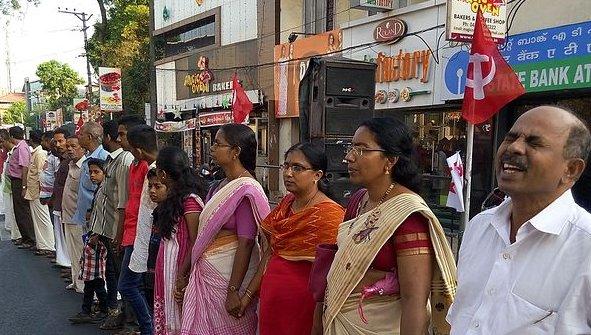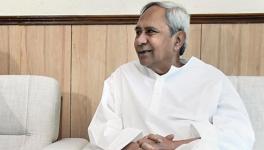The Reserve Bank on Demonetisation

People Against Demonetization, Image Courtesy: commons.wikimedia.org
The Reserve Bank of India has just come out with a document titled Macroeconomic Impact of Demonetisation: A Preliminary Assessment, which, while conceding that demonetisation did have an adverse impact on output, suggests that this impact would have got over by mid-February, because of the re-monetisation that has occurred in the interim. As the document puts it, “…the impact of the liquidity shock was assessed to largely dissipate by mid-February…”
The same document however provides data which show that by February 17 the total value of currency with the public was no more than about 60 percent of what it had been on the eve of demonetisation. Even a month later, by mid-March, the value of the currency with the public was just 70 percent of what it had been before demonetisation. Re-monetisation in short has still not gone far enough, even to this day, to undo the damage inflicted by demonetisation. Hence the claim that the adverse impact of demonetisation on output had got over by mid-February, even though the cash supply was still 60 percent of what it had been before demonetisation, is completely untenable.
True, when there is a shortage of cash, all kinds of cash substitutes come up for overcoming this shortage. A very common substitute consists simply of pieces of paper on which what one person owes to another is written. Among business units of course there is the institution of “trade credit” which is a cash-substitute, but such pieces of paper can be written by anybody, in favour of anybody else, in a situation of cash-shortage. Sometimes there are not even pieces of paper but mere oral commitments that the debt which would have been otherwise settled immediately through the use of money (and hence would not have taken the character of a debt at all) would instead be settled at some later date; and this allows transactions to take place even without the actual use of money. Such oral commitments in short function in effect as money substitutes.
All these devices however can work only at the margin, which is why the world does need money, and, in a country like ours with a large informal economy, money in the form of currency. The claim that the economy has bounced back to “normalcy” therefore could carry some credibility if, say, 98 percent of the value of the demonetised currency had been put back into the economy; but to make this claim when the extent of re-monetisation had only reached 60 percent defies reason.
In fact it is doubtful if the economy would ever bounce back to “normalcy” in the sense of a restoration of the pre-demonetisation state of affairs. This is so for at least three reasons. First, as the government itself has made amply clear, it does not intend to replace the entire value of demonetised currency with new notes, as it wants to force people towards cashless transactions. This of course is an authoritarian measure. Since cash transactions are costless while cashless digital transactions entail some payment to firms through whom such transactions are made, forcing people towards cashless transactions amounts ipso facto to making them part with their meagre resources for boosting the profits of financial firms. But the government has no compunctions on this score and whatever doubts it may have entertained earlier are likely to have got dissipated after the Uttar Pradesh election results.
The Attorney General Mukul Rohatgi had submitted to the Supreme Court in early December that the government would supply Rs 1.5-2 lakh crores less of new notes compared to the value of the demonetised notes, so that people are pushed into making more cashless transactions. Later, Arun Jaitley too confirmed this decision of the government not to replace the entire value of demonetised currency. If re-monetisation is not complete then the difficulties of the informal sector, far from being merely transitional, will become an enduring phenomenon. There would in this case never be any movement back to “normal”.
Secondly, even if the extent of re-monetisation is complete, the situation would still not get back to the pre-demonetisation “normal”. This is because even transitional disruptions of the economy leave behind enduring effects. One such obvious effect for instance would be on the distressed petty producers. Those petty producers who go out of business or get heavily into debt in order to meet their cash needs, would find it difficult to resume, or remain in, their businesses. In other words there would be a process of “centralisation of capital” that would be associated with the distress of petty producers and would endure, even if the cash shortage which caused this distress gets negated subsequently.
Thirdly, there is an important additional issue which is less understood and less talked about; and it relates to expenditure decisions. Expenditures are of two broad kinds. There are many expenditures, such as for instance the expenditure on consumer non-durables which in any period simply depend upon the level of current income. But there are many other expenditures whose level depends upon what has been happening in the economy over a longer period of time. The scale of such expenditures is larger in the current period, if the economy has been growing rapidly prior to the current period, than it would be if the economy’s growth rate has been small or non-existent.
Investment expenditure is an obvious instance of such expenditure. In a stagnant economy, no investment expenditure would be undertaken other than the bare minimum necessary for keeping the capital stock intact; but in a growing economy where markets too would be expanding, there would be larger investment for adding to capacity. Investment expenditure in short depends on the growth rate rather than the level of income.The same is true of several other expenditures such as the purchase of consumer durables. In a growing economy, people would be more confident about retaining their jobs (and even obtaining salary increases), because of which they are likely to spend more on consumer durables, at the same level of current income, than if the economy had been stagnant.
The level of all these expenditures depends therefore not on the level of income but upon its rate of growth. Now, suppose that in a growing economy, there is a reduction in the growth rate because of a cash shortage arising from demonetisation. This would reduce expenditures of the second kind, which would hit growth even further from the demand side. In such a case, even after the cash shortage is overcome, ie, even after the Central Bank has permitted everyone to withdraw new notes in lieu of the bank deposits they had been forced to make owing to demonetisation, the situation will not get back to “normal”. There would be an enduring slowdown that the economy would experience on account of the transitional cash-shortage that had been introduced by demonetisation.
Any such slowdown would further damage the petty production sector, so that its woes, which had begun because of the cash shortage, would accentuate even after this cash shortage gets over, owing to a demand shortage. Such a slowdown would worsen the condition of the workers through larger unemployment and wage-cuts.
Hence to argue, as the Reserve Bank has done, that the baneful consequences of demonetisation are now over, is doubly wrong. First, even if these consequences could be overcome with complete re-monetisation, we are a long way from such complete re-monetisation. And secondly even if there was complete re-monetisation, in the sense that all the bank deposits coerced from the people could be converted into new currency notes at their will, even then there would still be an enduring impact of this transient shock of demonetisation in the form of an economic slowdown. Putting it differently, the immediate adverse impact of demonetisation on the working people will be followed by a more enduring adverse impact, no longer because of cash shortage but because of a demand shortage that is triggered initially by the cash shortage.
These days of course some have even started denying any adverse impact on the people of the cash shortage induced by demonetisation. They fall back on two arguments: one invokes the third quarter GDP estimates released by the Central Statistical Organisation on February 28 (which were discussed in People’s Democracy dated March 18); the other invokes the BJP’s victory in Uttar Pradesh. In fact there is a bizarre argument that is being advanced these days, namely that since the BJP won in UP in the aftermath of demonetisation, those who had argued that demonetization was detrimental to the people were wrong. This is a bizarre argument because it is analogous to saying that since people in capitalist countries vote bourgeois parties to power, those who argue that capitalism is an exploitative system are wrong. Such an argument confuses a scientific proposition with popular opinion, suggesting that if people can be persuaded that some proposition is true then it must be true. The effect of demonetisation is a matter of scientific study; how people vote in an election cannot determine the outcome of that study.
Disclaimer: The views expressed here are the author's personal views, and do not necessarily represent the views of Newsclick
Get the latest reports & analysis with people's perspective on Protests, movements & deep analytical videos, discussions of the current affairs in your Telegram app. Subscribe to NewsClick's Telegram channel & get Real-Time updates on stories, as they get published on our website.
























